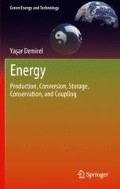Abstract
Various mechanisms and devices facilitate that an energy-producing process may drive another process requiring energy if energy coupling takes place between these processes. For example, in living systems, synthesis of adenosine triphosphate requires energy and therefore must couple with an energy providing process of electron transport chain. On the other hand, the hydrolysis of adenosine triphosphate supplies the energy needed in living systems. This chapter discusses a very simple and representative analysis of energy coupling in biochemical cycles and energy expenditure. There are five examples within the text and 15 practice problems at the end of the chapter.
Access this chapter
Tax calculation will be finalised at checkout
Purchases are for personal use only
References
Alberts B, Bary D, Lewis J, Raff M, Roberts K, Watson D (2002) Molecular biology of the cell, 4th edn. Garland, New York
Andrews AJ, Luger K (2010) A coupled equilibrium approach to study nucleosome thermodynamics. Methods Enzymol 488:265–285
Andriesse CD, Hollestelle MJ (2001) Minimum entropy production in photosynthesis. Biophys Chem 90:249–253
Brock TD, Brock KM, Ward DM (1986) Basic microbiology with applications, 3rd edn. Prentice Hall, Englewood Cliffs
Cairns CB, Walther J, Harken AL, Banerjee A (1998) Mitochondrial oxidative phosphorylation thermodynamic efficiencies reflect physiological organ roles. Am J Physiol Regul Integr Comp Physiol 433:R1376–R1393
Caplan RS, Essig A (1999) Bioenergetics and linear nonequilibrium thermodynamics. The steady state. Harvard University Press, New York
Demirel Y (2007) Nonequilibrium thermodynamics: transport and rate processes in physical, chemical and biological systems, 2nd edn. Elsevier, Amsterdam
Demirel Y (2008) Thermodynamically coupled transport in simple catalytic reactions. Int J Chem Reactor Eng 6:1–22
Demirel Y, Sandler SI (2002) Thermodynamics of bioenergetics. Biophys Chem 97:87–111
Garby L, Larsen PS (1995) Bioenergetics. Cambridge, New York
Heinrich R, Schuster S (1998) The modeling of metabolic systems. Structure, control and optimality. Biosystems 47:61–77
Korzeniewski B (1997) Thermodynamic regulation of cytochrome oxidase. Mol Cell Biochem 174:137–141
Marks DB (1999) Biochemistry. Kluwer, New York
Nath S (1998) A thermodynamic principle for the coupled bioenergetic processes of ATP synthesis. Pure Appl Chem 70:639–644
Purves WK, Sadava D, Orians GH (2004) Life: the science of biology. MacMillian, Amsterdam
Sambongi Y, Ueda I, Wada Y, Futai M (2000) A biological molecular motor, proton translocating ATP synthase: multidisciplinary approach for a unique membrane enzyme. J Bioenerg Biomem 32:441–448
Schäfer G, Penefsky H (eds) (2010) Bioenergetics: energy conservation and conversion. Springer, Berlin
Stucki JW (1980) The optimal efficiency and the economic degrees of coupling of oxidative phosphorylation. Euro J Biochem 109:269–283
Stucki JW (1980) The thermodynamic-buffer enzymes. Euro J Biochem 109:257–267
Stucki JW (1984) Optimization of mitochondrial energy conversions. Adv Chem Phys 55:141–167
Stucki JW (1991) Non-equilibrium thermodynamic sensitivity of oxidative phosphorylation. Proc Biol Sci 244:197–202
Stucki JW, Compiani M, Caplan SR (1983) Efficency of energy-conversion in model biological pumps optimization by linear nonequilibrium thermodynamics relation. Biophys Chem 18:101–109
Soboll S (1995) Regulation of energy metabolism in liver. J Bioenerg Biomem 27:571–582
Soboll S, Stucki JW (1985) Regulation of the degree of coupling of oxidative phosphorylation in intact rat-liver. Biochim Biophys Acta 807:245–254
Tomashek JJ, Brusilow WSA (2000) Stoichiometry of energy coupling by proton-translocating ATPases: a history of variability. J Bioenerg Biomem 32:493–500
Wilson K, Walker J (2005) Principals & techniques of biochemistry and molecular biology, 6th edn. Cambridge University Press, Cambridge
Woitczak L, Schonfeld P (1993) Effect of fatty acids on energy coupling processes in mitochondria. Biochim Biophys Acta 1183:41–57
Author information
Authors and Affiliations
Rights and permissions
Copyright information
© 2012 Springer-Verlag London Limited
About this chapter
Cite this chapter
Demirel, Y. (2012). Energy Coupling. In: Energy. Green Energy and Technology. Springer, London. https://doi.org/10.1007/978-1-4471-2372-9_10
Download citation
DOI: https://doi.org/10.1007/978-1-4471-2372-9_10
Published:
Publisher Name: Springer, London
Print ISBN: 978-1-4471-2371-2
Online ISBN: 978-1-4471-2372-9
eBook Packages: EngineeringEngineering (R0)

